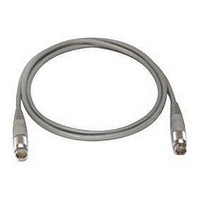11730D AGILENT TECHNOLOGIES, 11730D Datasheet - Page 102

11730D
Manufacturer Part Number
11730D
Description
SENSOR CABLE, 50FT
Manufacturer
AGILENT TECHNOLOGIES
Datasheet
1.11730D.pdf
(234 pages)
Specifications of 11730D
Leaded Process Compatible
No
Peak Reflow Compatible (260 C)
No
Cable Length
50ft
Features
Reduces RFI Effect On Low Power Readings With Improved Shielding Design
Cable Assembly Type
Sensor
Cable Color
Gray
Rohs Compliant
No
For Use With
8480 & E-Series Power Sensors
Lead Free Status / RoHS Status
Contains lead / RoHS non-compliant
- Current page: 102 of 234
- Download datasheet (7Mb)
Isolation
High isolation in switches is important to almost every
measurement application, because it prevents unwanted signals
from interfering with the desired signal. Isolation is the amount
that the unwanted signal is attenuated before it is detected at the
port of interest. Agilent switches have high isolation, with typical
values >90 dB to 18 GHz and >50 dB to 26.5 GHz. High isolation
can be particularly important in measurement systems where
signals from sources are being routed. If too much power from an
unselected source is allowed to flow through a device under test,
measurement results will not be accurate.
SWR
The standing wave ratio (SWR) of a switch specifies how well the
connectors and switching signal path are matched to an ideal
50 ohm transmission line. Low SWR is crucial in test set design
when signal routing configurations involve multiple components in
series, thereby adding to measurement uncertainty. SWRs of
1.1 to 1.5 are typical in Agilent switches.
Repeatability
Repeatability plays an important role in any test system. In test
applications where accuracies of less than a few tenths of a dB
are required, the system designer must consider the effects of
switch repeatability in addition to test equipment capabilities.
In automated test systems where switches are used for signal
routing, every switch will add to the repeatability error. Such errors
cannot be calibrated out of the system due to their random nature.
Agilent switches are designed for high repeatability, 0.03 dB
maximum over 5 million cycles.
Repeatability is a measure of the change in a specification from
cycle to cycle over time. When used as a part of a measurement
system, switch repeatability is critical to overall system
measurement accuracy. Repeatability can be defined for any of
the specifications of a switch, which includes: insertion loss,
reflection, isolation and phase. Insertion loss repeatability is
specified for all Agilent switches, as this tends to be the
specification most sensitive to changes in switch performance.
Factors that affect insertion loss repeatability include:
• Debris
• Contact pressure
• Plating quality
• Contact shape and wiping action
Debris is generated in a switch when two surfaces come in
contact during movement. The debris may find its way between
contacts, causing an open circuit. Agilent has developed processes
that control contamination and debris generation to minimize
these effects.
Switch contacts are typically gold plated to maximize conductivity
and minimize surface corrosion. Special plating materials, surface
finish, contact shape and wiping pressure all combine to minimize
surface effects on insertion loss repeatability.
Contact resistance is inversely proportional to contact pressure.
Insufficient pressure increases life but also increases contact loss.
Too much pressure damages the contact surfaces, with little
insertion loss improvement. Contact surface wiping provides a
means for breaking through surface corrosion and moving debris
away from the contacts. This allows the switch to clean the
contact surfaces with each switch cycle.
Life
The life of a switch is usually specified in cycles, i.e. the number of
times it switches from one position to another and back. Agilent
determines life by cycling switches to the point of degradation.
Typically, Agilent switches, in life cycle tests, perform to
specifications for at least twice as many cycles as warranted.
Four Agilent switch series have a specified life of 5 million cycles.
This long life results in lower cost of ownership by reducing
periodic maintenance, downtime and repairs.
Agilent offers a broad line of coaxial switches, covering up to
50 GHz, for use in test and measurement applications. All switches
use magnetically-latched solenoids and are primarily designed with
break-before-make RF contacts for test simplicity.
www.agilent.com/find/mta
Switches (continued)
Switches
91
15
Related parts for 11730D
Image
Part Number
Description
Manufacturer
Datasheet
Request
R

Part Number:
Description:
Agilent Tachyon DX4+ (HPFC-5700) Dual-Channel 4-Gb Fibre Channel Controller With The Data Integrity Field (DIF) Feature
Manufacturer:
Agilent Technologies, Inc.

Part Number:
Description:
Manufacturer:
Agilent Technologies, Inc.
Datasheet:

Part Number:
Description:
Manufacturer:
Agilent Technologies, Inc.
Datasheet:

Part Number:
Description:
Manufacturer:
Agilent Technologies, Inc.
Datasheet:

Part Number:
Description:
Manufacturer:
Agilent Technologies, Inc.
Datasheet:

Part Number:
Description:
Manufacturer:
Agilent Technologies, Inc.
Datasheet:

Part Number:
Description:
Manufacturer:
Agilent Technologies, Inc.
Datasheet:

Part Number:
Description:
Manufacturer:
Agilent Technologies, Inc.
Datasheet:

Part Number:
Description:
Manufacturer:
Agilent Technologies, Inc.
Datasheet:

Part Number:
Description:
Manufacturer:
Agilent Technologies, Inc.
Datasheet:

Part Number:
Description:
Manufacturer:
Agilent Technologies, Inc.
Datasheet:

Part Number:
Description:
Manufacturer:
Agilent Technologies, Inc.
Datasheet:

Part Number:
Description:
1.0625 GBd Fibre Channel 10x10 mm QFP Transceiver Chip (Recommend HDMP-1636A for new designs)
Manufacturer:
Agilent Technologies, Inc.
Datasheet:

Part Number:
Description:
Manufacturer:
Agilent Technologies, Inc.
Datasheet:

Part Number:
Description:
1.0625-2.125 GBd Serdes Circuits: SSTL_2
Manufacturer:
Agilent Technologies, Inc.
Datasheet:










